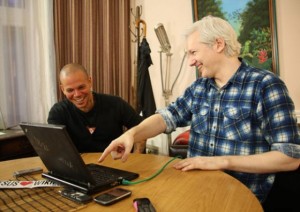Protest songs have always been an important mode of political discourse. Easily produced and disseminated, good protest songs and the artists that create them can infiltrate mass consciousness and gain relevance beyond the realm of the strictly political. We’ve all listened to Bob Marley or Bob Dylan songs, even if we don’t spend much time thinking about their overt political content. Likewise, most of us have heard or read the phrase “Fuck the police” somewhere, even if we don’t know who N.W.A was or have never experienced police brutality.
The success of the protest song does not lie in the social change it directly contributes to, but in its effectiveness in creating and disseminating a certain vocabulary beyond its initial target audience. They are meant to go viral. If a song goes viral enough, everyone becomes familiar with and starts quoting its lyrics. With words, inevitably, come thoughts. And thoughts, protest artists hope, lead to action and change.
Obviously, this does not always work out as artists intend, but the point is that even if their ideas never coalesce into a mass movement for change, they still get to frame social and political conflicts experienced by many people through their own language.
Last Wednesday, November 13th, Puerto Rican rap group Calle 13 released its long-awaited first single off of its upcoming fifth album. Aptly titled “Multi-Viral,” the new song does not stray far from the group’s clearly established working-class, left-leaning political aesthetic. Its message – mainly a call against news manipulation but also a criticism of political repression and Big Pharma – is not new either.
What is new is the format in which the piece is presented, as well as the voices used to frame the song’s message.
When recording this newest piece, Calle 13 shed their regional focus and went global, bringing in American guitarist and labor activist Tom Morello, Arab-Israeli protest singer Kamilya Jubran, and even Australian “hactivist” Julian Assange.

Through their multilingual voices, the artists have produced a protest song for the 21st century, aptly reflecting the complex relationships between globalized protest movements.
The use of different languages is a strong indicator of how this style of song breaks borders, in more than one sense. Words are sung or spoken in Spanish, English, Arabic and French. The literal meaning of the lyrics might seem generic, but the use of these tongues – referencing protest movements such as 15-M in Spain, #YoSoy132 in Mexico, WikiLeaks and the Occupy Movement, the Arab Spring, and possibly even the iconic French protests of 1968 – focuses the message and further adds to the theme of global solidarity between egalitarian projects for social change.
The tools used to put the song together are also noteworthy. As Calle 13 vocalist René Pérez stated through Twitter, he and Assange wrote the song lyrics partly by sourcing lines from fan tweets. In an ode to the Internet age, the song is both created through online resources and initially published through online media sites such as YouTube and Spotify.
The presence of Assange in the song and video is also innovative, since as an object of protest discourse he is crafting his own message for the artistic project. Calle 13 could easily have included an old Assange sound bite as part of the song, but the choice to have the man contribute lyrics himself blurs the line between the object of a discussion and an active participant in it.
The inclusion of activists like Morello and Jubran brings their own struggles into the song, even if they are not explicitly mentioned. Thus the whole “protest song experience” transcends the YouTube clip and bring with it a part of the lives of those presenting the message, including those who did not write any of it.
The video presentation itself is an interesting artistic choice. Absent are played-out images of police lines, street rallies and protesters wearing Guy Fawkes masks. The clip is instead made of up of four minutes and twenty-eight seconds of seizure-inducing flashing lights and references to coding and computer programs. The glitch art aesthetic is a nod to the online networks that constitute the newest battlefield between the state and protesters in most countries. It also references the modes of social control that national agencies (read: the NSA) impose over international subjects, as well as the online vehicle of expression that these same subjects can use to undermine the validity of institutionalized control.
“From Cairo to Quito, a new world is forming,” Julian Assange speaks into an ad hoc recording mic set up within the confines of Ecuador’s London embassy, where he has been taking refuge since July 2012, when British authorities issued an arrest warrant for the WikiLeaks founder due to charges of sexual abuse in Sweden.
Assange’s self-assurance may seem a bit naïve, but his most recent project might indeed help advance the new world of globalized protest that has been surging since the 2009 economic crisis. If Calle 13 is successful, the words of this song will stick in the minds of listeners across the world, adding one more drop to the downpour of outcries that began with the Occupy movement and are still heard from Egypt to Latin America.
Maybe no one will be inspired by the single to take to the streets, but perhaps years from now people will look back and think of “Multi-Viral” as part of the soundtrack of the global protest movements that have so far defined the 2010’s, whatever their achievements might ultimately be.
